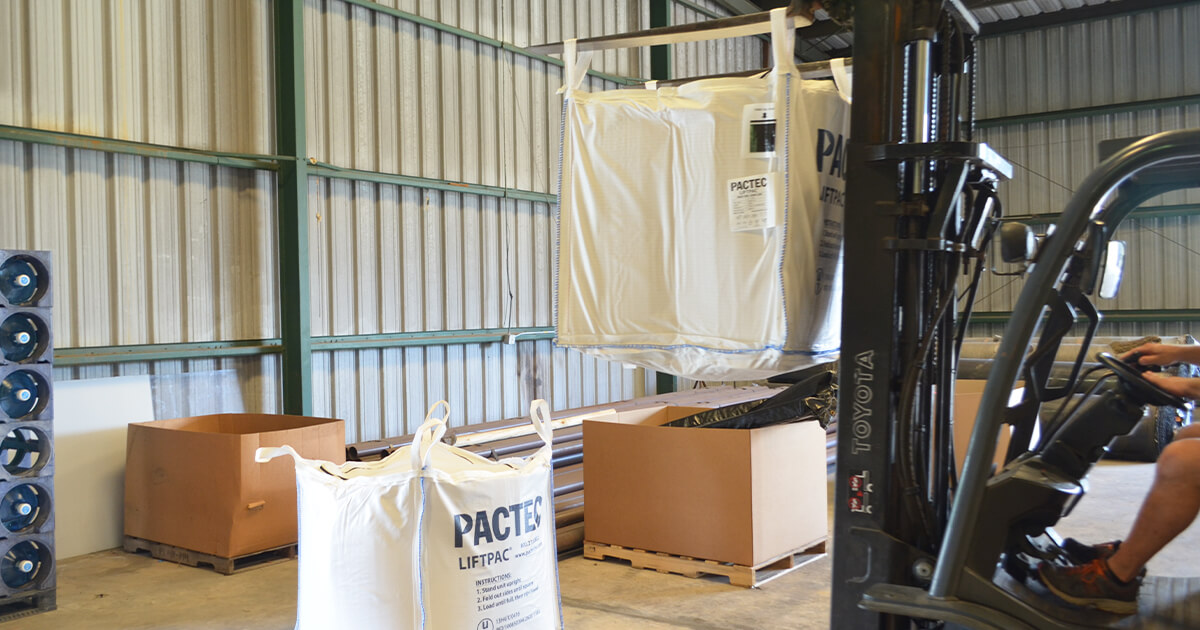As a more affordable and easier-to-use alternative to rigid containers, flexible intermediate bulk containers (commonly known as FIBCs or bulk bags), are growing in popularity and availability. But knowing how to properly handle, store and transport these flexible bulk container bags to ensure everyone's safety is very important in preventing costly, dangerous, or catastrophic spills or accidents.
For companies looking to safely use large flexible packaging or smaller FIBCs as part of their material handling processes, PacTec has put together this quick reference guide based on industry best practices and DOT safe handling requirements. The FIBCA (Flexible Intermediate Bulk Containers Association) has also produced a very handy video you may find beneficial:
There are many variations of flexible bulk bags available, including basic FIBC bags, UN-rated bulk sacks, IP rated packages and easy-to-use bulk container bags designed to fit roll off dumpsters. If you need assistance in determining which type of flexible bulk bag would be best suited to your needs, our team would be happy to help, or you can review the guide below.
Safe Handling of FIBC bulk container bags: Quick DO’S & DON’TS
We know bulk bags are an ideal packaging solution for dry flowable material, based on their superior capacity and cost-to-product weight, but they also present unique dangers given their construction from woven polypropylene fabric. This simply means that the handling guidelines differ from those of rigid containers, but by following a few simple steps, bulk bag use can prove to be safe and effective. Click here to download the Flexible Intermediate Bulk Container Association (FIBCA’s) Safe Handling Guidelines for a more in-depth look at safe-handling practices.
When handling a flexible bulk container bag…
| DO | DON'T |
|
|
Safe Storage of FIBC Bulk Container Bags: Best Practices
Now that your flexible packaging has been safely loaded and handled, let’s explore some industry best practices for safely storing them for use of their contents later, or during temporary storage before disposal. Following these simple tips for keeping your bulk bags safely stored can prevent unsafe conditions and protect their contents from spoiling or release.
- Keep bags away from nails or other sharp objects. Ensure the ground and walls are free from objects or protrusions that can tear, cut, or rip the bags.
- Store in a dry location away from direct sunlight. Leaving the bags exposed to direct sunlight or UV rays for extended lengths of time can lead to bag failure, as the outer material is only rated to withstand a given amount of exposure. Best practice is to store in a covered location or by properly tarping them.
- Only stack bags if designed to do so. Many bulk container bags are designed to be stacked, but not all, so only stack those designed for it. Also ensure stability once placed, and if stacked, do so in a pyramid layout.
- It is best to store full bags on the floor or pallets. While some can be placed in pallet racks or other storage locations, best practice is to keep them at ground level to prevent falling hazards.

How to Safely Transport your Bulk Containment Bags
When transporting loaded bulk sacks or super sacks to another location, or loading them onto trucks/railcars for disposal, it is imperative to follow the recommended instructions on the packaging or provided by the manufacturer. Ignoring these can cause the load to shift within the flexible packaging, causing unnecessary hazardous conditions.
- Always follow recommended instructions on packaging. PacTec also provides printed safe handling instructions and in many cases videos for each of their products.
- Always use the proper equipment. Whether you are lifting cubic yard bags with a forklift with or without a pallet or engaging the use of a crane to lift a 30 yd3 bag, using the proper equipment is imperative. If you have limited equipment available, reach out to our team for consultation on alternative safe transport methods.
- When stacking bags on a pallet do so in a pyramid structure. This bears repeating as most FIBCs are not designed to stack directly on top of one another. By using the pyramid method, you ensure the stability of the loads in all packages.
- Avoid any sudden movements when transporting bags. Sudden breaking on a forklift can send a bag flying from the tines, sharp turns at high speeds can sling them from the tines, etc. Take care to avoid sudden movements to prevent disaster.




